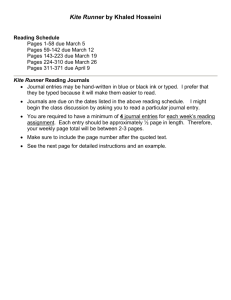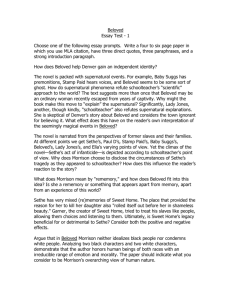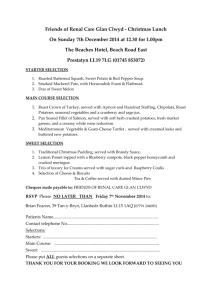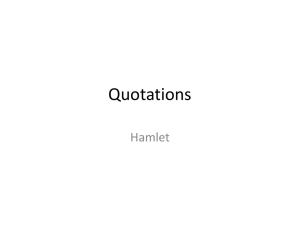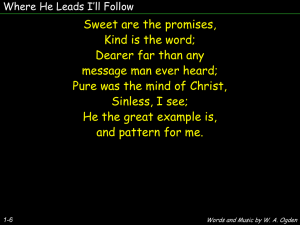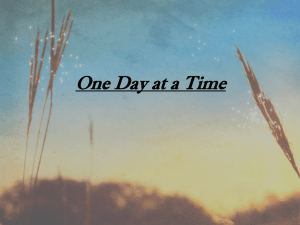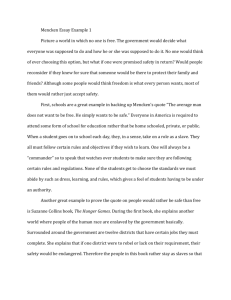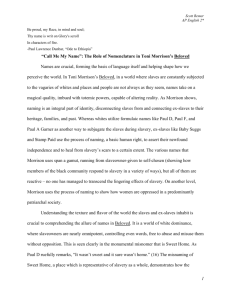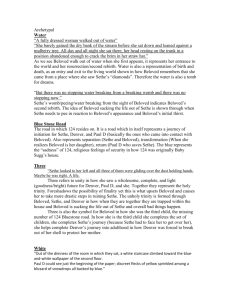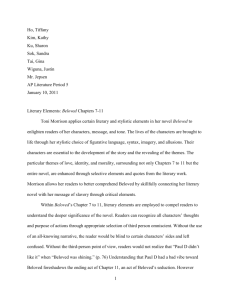Beloved Reading Journals
advertisement
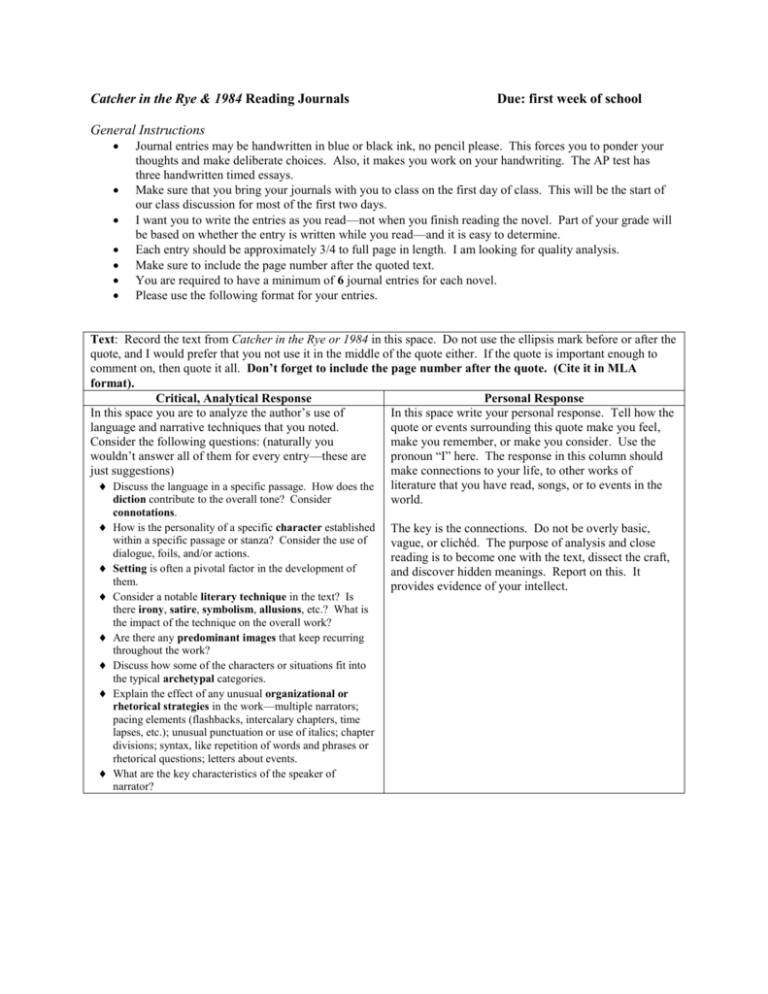
Catcher in the Rye & 1984 Reading Journals Due: first week of school General Instructions Journal entries may be handwritten in blue or black ink, no pencil please. This forces you to ponder your thoughts and make deliberate choices. Also, it makes you work on your handwriting. The AP test has three handwritten timed essays. Make sure that you bring your journals with you to class on the first day of class. This will be the start of our class discussion for most of the first two days. I want you to write the entries as you read—not when you finish reading the novel. Part of your grade will be based on whether the entry is written while you read—and it is easy to determine. Each entry should be approximately 3/4 to full page in length. I am looking for quality analysis. Make sure to include the page number after the quoted text. You are required to have a minimum of 6 journal entries for each novel. Please use the following format for your entries. Text: Record the text from Catcher in the Rye or 1984 in this space. Do not use the ellipsis mark before or after the quote, and I would prefer that you not use it in the middle of the quote either. If the quote is important enough to comment on, then quote it all. Don’t forget to include the page number after the quote. (Cite it in MLA format). Critical, Analytical Response Personal Response In this space you are to analyze the author’s use of In this space write your personal response. Tell how the language and narrative techniques that you noted. quote or events surrounding this quote make you feel, Consider the following questions: (naturally you make you remember, or make you consider. Use the wouldn’t answer all of them for every entry—these are pronoun “I” here. The response in this column should just suggestions) make connections to your life, to other works of Discuss the language in a specific passage. How does the literature that you have read, songs, or to events in the diction contribute to the overall tone? Consider world. connotations. How is the personality of a specific character established within a specific passage or stanza? Consider the use of dialogue, foils, and/or actions. Setting is often a pivotal factor in the development of them. Consider a notable literary technique in the text? Is there irony, satire, symbolism, allusions, etc.? What is the impact of the technique on the overall work? Are there any predominant images that keep recurring throughout the work? Discuss how some of the characters or situations fit into the typical archetypal categories. Explain the effect of any unusual organizational or rhetorical strategies in the work—multiple narrators; pacing elements (flashbacks, intercalary chapters, time lapses, etc.); unusual punctuation or use of italics; chapter divisions; syntax, like repetition of words and phrases or rhetorical questions; letters about events. What are the key characteristics of the speaker of narrator? The key is the connections. Do not be overly basic, vague, or clichéd. The purpose of analysis and close reading is to become one with the text, dissect the craft, and discover hidden meanings. Report on this. It provides evidence of your intellect. For example: Text: Paul D smiled then, remembering the bedding dress. Sethe was thirteen when she came to Sweet Home and already iron-eyed. She was a timely present for Mrs. Garner who had lost Baby Suggs to her husband’s high principles. The five Sweet Home men looked at the new girl and decided to let her be. They were young and so sick with the absence of women they had taken to calves. Yet they let the iron-eyed girl be, so she could choose in spite of the fact that each one would have beaten the others to mush to have her. It took her a year to choose—a long, tough year of thrashing on pallets eaten up with dreams of her. A year of yearning, when rape seemed the solitary gift of life. The restraint they had exercised possible only because they were Sweet Home men—the ones Mr. Garner bragged about while other farmers shook their heads in warning at the phrase. “Y’all got boys,” he told them. “Young boys, old boys, picky boys, stroppin boys. Now at Sweet Home, my niggers is men every one of em. Bought em thataway, raised em thataway. Men every one.” (page 10) Critical Analysis: Response: This passage uses flashback as Paul D and Sethe I find this passage very intriguing. I know this is a slave reminisce about life back on Sweet Home. Paul D narrative—and to write about these men as slaves is to recalls in his mind and the narrator tells us his thoughts be expected. But the way Morrison suggests that they when Sethe came to live at Sweet Home. This use of were more than the stereotypical slave is interesting how third person omniscient point of view is important for she does that. I am not sure what is going on—Mr. the reader to understand what happens—not only from Garner seems to take pride in his slaves. I know some Paul D’s perspective but from Sethe’s as well. If we white slaveholders valued their slaves, but Mr. Garner only knew Sethe’s thoughts, we would not understand seems quite different. I am surprised that Morrison, an the impact she had when she came to live at Sweet African-American writer, would make Mr. Garner a Home. The juxtaposition of these two ideas—the way decent human being who likes his slaves. If this book is the slaves at Sweet Home act and their desires—is an going to be an indictment of slavery and slaveholders, interesting manipulation of language by Morrison. It then I am a bit confused here. I really picked up on the would be easy to see these slaves as “non-human” since word “restraint” in this paragraph. Joseph Conrad she says that they have sex with the calves in the admired the “restraint” of the Africans in Heart of absence of women, but the inclusion of the detail that Darkness so much. Morrison appears to admire this they practiced “restraint” with Sethe shows that they quality in these characters as well. I think “restraint” is were men—real men. If they had “raped” her, which such an important word for the 21st century where excess would be expected of slaves who used calves for sexual seems to be the norm—not restraint. I love the way pleasure, then Morrison would validate the myth that Morrison teases us with details and facts about what slaves were not real men. But to practice “restraint” for happened at Sweet Home. I know the name Sweet one year—indicates that these Sweet Home men were Home must be ironic—I mean it was a place of exactly what Mr. Garner bragged about to other slave enslavement for Baby Suggs and her children, but it owners—his slaves were real men. The way Morrison seems so nice and pleasant—almost “sweet,” yet the juxtaposes the words “men” and “niggers” is also slaves were not free—so how “sweet”? I think Morrison interesting in what she is doing and the life she creates at teases us to want to know more than the typical salve Sweet Home. narrative here—we want to know the precise details about this place. What made it good, yet what made it a terrible place also. I am intrigued by Baby Suggs’ husband’s “high principles”—can a slave have “high principles”—and yet I know as soon as I say that—of course he can! I feel at the mercy of Morrison’s manipulation of language—and for some reason I like it.
